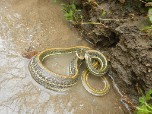 |
Arid Land Ribbon Snake Range Map
|
|
|
 |
 |
 |
 |
 |
 |
 |
Arid Land Ribbon Snake Video
No Video Available
|
|
|
 |
 |
 |
 |
 |
 |
 |
Arid Land Ribbon Snake Juvenile

|
|
|
 |
 |
 |
 |
 |
 |
|
Arid Land Ribbon Snake (Thamnophis proximus diabolicus)
Description: The Arid Land Ribbonsnake (Thamnophis proximus diabolicus) is a small to medium-size non-venomous serpent, with most adults reaching sexual maturity between 20 and 30 inches in total length. Like other Texas gartersnakes, the Arid Land Ribbonsnake has three stripes that run longitudinally on its body. The most distinctive stripe is the broad yellowish-orange one that runs along the spine. The other two pale lines run lengthwise along the sides on the third and fourth scale rows above the belly scales. The background coloration of the body varies from nearly black to dark gray to olive, while the head, which is significantly wider than the neck, is colored like the body and has a small yellow dot near the center. The eyes are characteristically large and have round pupils; there is also a white vertical bar directly in front of each eye. The tail is extremely long and on some individuals can make up almost 30 percent of the total length.
Habitat: This semiaquatic snake occurs a wide range of often shrubby habitats in the vicinity of streams, lakes, ponds, sloughs, ditches, swamps, and marshes. Often it is in water-edge vegetation. Sometimes it can be found in terrestrial habitats but generally close to water. Hibernation sites may be in upland areas near or some distance from water.
Range: Eastern New Mexico, western Texas, and northeastern Mexico.
Found in these States:
NM |
TX
Diet: Eats frogs, toads, tadpoles, salamanders, fishes, insects, earthworms, occasionally carrion.
Reproduction: Gives birth to litter of 4 to 27 young, mainly July-September. Sexually mature in 2nd or 3rd year.
Status: Listed as Secure in Texas and Vulnerable in New Mexico.
»» Kingdom: Animalia - Animals
»» Phylum: Chordata - Chordates
»» Subphylum: Vertebrata - Vertebrates
»» Class: Reptilia - Reptiles
»» Order: Squamata - Scaled Reptiles
»» Suborder: Serpentes
»» Superfamily: Colubroidea
»» Family: Colubridae - Colubrids
»» Genus: Thamnophis
»» Species: Thamnophis proximus - Western Ribbon Ssnake
»» Subspecies: Thamnophis proximus diabolicus - Arid Land Ribbon Snake
This article uses material from the Wikipedia article "Thamnophis proximus", which is released under the Creative Commons Attribution-Share-Alike License 3.0. Content may have been omitted from the original, but no content has been changed or extended.
|
|













